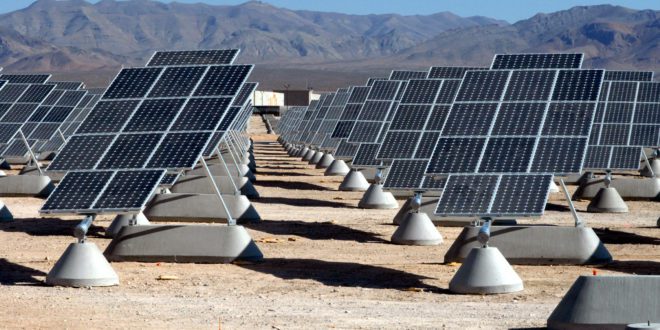The need for cost-efficient renewable energy resources means the number of solar photovoltaic (PV) plants continues to increase as does investment in PV technology for improved performance. One new technology in this area is bifacial PV, which is set to gain credence and be more widely used in projects for the future.
Most large-scale PV installations use monofacial panels. This means just one side of the panel is designed to absorb the sunlight and convert it to electricity. Bifacial panels also open up the reverse side to enable the additional collection of light reflected from the ground, meaning that more energy can be produced from the same module. Such an increase in energy output means that less land may be needed for the same energy output. In 2015, only around 0.1% of PV installations used bifacial technology but this is expected to have increased to around 0.3% this year[i]. While the numbers are still very small, RINA is discovering that this technology is rapidly gaining acceptance and is working with stakeholders and investors to validate the return on investment from its use.
Both monocrystalline and polycrystalline silicon PV technology are being used to produce bifacial panels and they can be used with tracking systems or on fixed-tilt installations. Although the technology has been around for decades, it has only relatively recently achieved mainstream commercial viability for use in large-scale PV plants. Facilitating the entry of bifacial PV into the market has been driven generally by technological trends in PV modules: specifically, the rise in modules with transparent glass on the rear side as well as the front side and the development of PV cells with rear side electrical contacts that are just a small step change away from those required by bifacial PV cells. These advances mean that bifacial panels can be produced using similar manufacturing steps as monofacial panels and only at a very small additional cost.
The energy output gains from the use of bifacial PV panels very much depends on the design of installation which can be complex, but tests and modelling of the technology show these could be anywhere between 5 and potentially 20%. The efficiency of the rear of the panel typically sits at around 70%-75% of that of the front side.
While the energy output gains bifacial panels offer mean they will probably only be considered for new installations, their return on investment looks appealing and, once proven, they are likely to be the PV of choice for the future.
RINA is working closely with manufacturers, investors and other clients to improve accuracy in the modelling and validation of the potential energy yield gains for bifacial projects. Oliver Davies, Performance Manager at RINA, commented, “There are issues that developers and investors need to be aware of but, thanks to the work and research we have carried out to date, we are well placed to help and provide information to build confidence in the validity of the benefits this technology offers. Our work includes links to manufacturers and software developers producing modelling software. We are covering various aspects of modelling, including detailed albedo research, aiming to reduce the uncertainties for banks and investors considering projects which utilise bifacial panels.”
Albedo is a measure of the diffuse reflection of solar radiation of a surface. Surfaces such as snow, for example, have much higher albedo levels than dark soil. The higher the albedo the higher the gains from having the rear face of the PV panel exposed. There is no standard measurement of albedo but, based on the colour of the ground and available satellite data, the albedo level along with other climatic conditions of an installation site are included within energy gain models.
“Bifacial technology is generally similar to monofacial in how it works and so, in theory, there should not be an issue with its use. Banks and investors, however, need to be convinced of how it will perform before committing funds to projects. The lack of published validations and public domain test data for bifacial installations means we need to use models to forecast return on investment,” continued Davies.
The greater energy output from the use of bifacial panels will mean higher operating currents. There is some concern surrounding heating and degradation of the modules over time, but higher standards of tests are being introduced which it is believed will increase the confidence levels for investors in the technology. PV plant equipment needs to be suitable for higher level currents but, as energy gains are anticipated to be no more than around 20%, there is typically little, or no change required to ratings and cost of the surrounding electrical infrastructure.
Jenna Holder, PV Module Specialist at RINA concluded, “There are a number of research institutes, PV manufacturers and other bodies with small bifacial test sites. We have been modelling and comparing test results and measurement data with simulation model outputs. Our work means we are in an excellent position to help project investors with yield analysis and to validate potential PV projects.”
The support RINA offers to investors in PV plants includes qualification of the increase in energy produced by bifacial panels, along with advice on project improvements and validation. RINA provides technical due diligence prior to investment with feasibility studies and consideration of areas such as whether gains of installing reflective ground materials, for example, outweigh the additional cost, maintenance, etc. involved in their use. Several leading PV manufacturers now produce bifacial panels and RINA can evaluate any model type selected for a project.
RINA has extensive experience in PV technology, and its technical advisory services have been used by major investors throughout the world. Its work with bifacial panels, test standards and software modelling to prove their benefit means it is in a prime position to support new projects in this area.
[i] Radovan Kopecek and Joris Libal, bifiPV2018
 Alternative Energy HQ solar power for homes, wind energy, and bio fuel issues
Alternative Energy HQ solar power for homes, wind energy, and bio fuel issues







